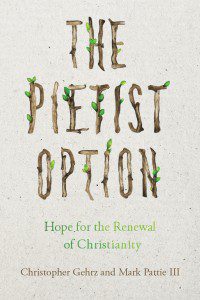According to the Public Religion Research Institute, white evangelicals have fallen from 23% of the U.S. population to 17% in just over a decade. And the future doesn’t look very promising: that religious group accounts for only 8% of Americans aged 18-29. Now, evangelicals altogether still make up almost a quarter of the population, but that’s only because a third of them are persons of color. And historian Thomas Kidd rightly worries that being “inextricably tied to Republican politics” — even those of the current president — has made “evangelical” an “essentially divisive term among Bible-believing Christians, as many African Americans, Hispanics, and others cannot identify with the political ramifications of being an ‘evangelical,’ especially after the election of President Trump…”
“Before the 2016 election,” wrote Kidd, a co-founder of this blog, “I was comfortable with using the term ‘evangelical’ for people like me, in spite of the problems with it. Now I am not so sure…. Historians (including me) will keep on using the term ‘evangelical’ and examining what it has meant in the past. But in public references to ourselves, it is probably time to put ‘evangelical’ on the shelf.”
When another prominent Southern Baptist mused publicly about dropping “evangelical” in the midst of last year’s presidential campaign, I suggested to evangelical readers of my own blog that they consider another term: Pietist. After all, Pietism was a key source for the 18th century revivals that we tend to associate with evangelicalism in the English-speaking world. And it shares several of evangelicalism’s core emphases — without being implicated in American partisan politics.
 But at this point, I don’t really care whether people like Kidd and me stick with “evangelical” or pick an alternative. What’s happening is not simply a problem of nomenclature or branding. Whatever we call ourselves, we evangelicals need to take seriously the accelerating decline and impaired witness of our movement and consider potential sources of renewal.
But at this point, I don’t really care whether people like Kidd and me stick with “evangelical” or pick an alternative. What’s happening is not simply a problem of nomenclature or branding. Whatever we call ourselves, we evangelicals need to take seriously the accelerating decline and impaired witness of our movement and consider potential sources of renewal.
We’ll need help from several sources. But let me start by suggesting that we consider what Evangelical Covenant pastor Mark Pattie and I are calling “the Pietist option.”
(I know, I know… I’ll talk about Rod Dreher again next month.)
In three weeks our book will hit shelves and you can read more fully what we mean by that phrase. But let me preview our argument by suggesting four basic, though not simple, steps to renewal. They’re drawn from the history of a religious ethos that started in 17th century Germany with the Lutheran pastor Phillip Jakob Spener and has continued to awaken Christianity in many times and places since.
Decide anew to follow Jesus
First, the Pietist option requires a conscious decision to (in Mark’s words) “put one’s faith in God and so to allow hope in the fulfillment of God’s promises to blossom and bear the fruit of love….”
This may sound obvious, even trite. But we can’t move forward without agreeing to make this kind of commitment. (Indeed, Mark suggests that it’s an ongoing decision, made day after day.) For what we’re after can’t be inherited from family or absorbed from a supposedly Christian culture. It requires us to reject the anxious pull of fear, the angry rhetoric of division, and the deceptive security of power and prosperity.
“The Pietist option,” we explain in our introduction, “is to opt in to a distinctively hopeful way of coming back to Jesus: growing to become more and more like him, to live at peace as part of his body, and fulfilling his mission in service to others.”
Approach Scripture as an altar of the living God
If this sounds prosaic… Well, in most respects, Spener thought he was simply recovering what Martin Luther had already taught — starting with the extensive use of Scripture. “The more at home the word of God is among us,” Spener wrote, “the more we shall bring about faith and its fruits.” Not only by hearing the word preached, but by personal and small group Bible study, he dreamed that Christians’ “spiritual life will be wonderfully strengthened and they will become altogether different people.”
In a time when the Bible is no more than an iPhone away, we can be fooled into thinking that God’s word is already “at home… among us.” But we evangelicals too often read the Bible in ways that protect us against its transformative power. We use it like a rulebook or we cherry-pick our favorite proof-texts. Instead, we should read the Bible prayerfully and holistically, recognizing it as what our denomination has called “an altar where one meets the living God and receives personally the reality of redemption.”
Make your faith active in love of neighbor
Evangelicals like to think of themselves as guardians of historical orthodoxy, but such faith is only meaningful if it makes a difference in how we act. For example, we can proclaim the historicity of the Resurrection all we want, but if we live in fear — whether of sickness and old age or terrorism and immigration — we are in effect denying that Christ has truly conquered the grave.
So while other evangelicals might want to draw still clearer doctrinal lines demarcating themselves from “the spirit of our age” and even other followers of Jesus Christ, Pietists find orthodoxy both necessary and insufficient. “It is by no means enough to have knowledge of the Christian faith,” wrote Philipp Spener in 1675, “for Christianity consists rather of practice.” In the twentieth century, Evangelical Covenant theologian Don Frisk noted that “our forefathers rarely asked, when they met their friends and neighbors, ‘What do you believe?’ But sooner or later they were sure to ask, ‘Are you alive spiritually?’ ‘Have you found life in Christ?’”
The new life is the result of new birth. But Frisk emphasized that being “converted to Christ is always in a sense to be converted (turned) to the world. It is to see the world through the eyes of Christ, to share his compassion, to perceive his will for the world, and to strive to follow it.” If we simply “put this love into practice,” Spener believed, “practically all that we desire will be accomplished.”
Form yourselves for unity
Alas, it’s hard to love our neighbors when Christians scarcely seem to love each other. “For the whole law is summed up in a single commandment,” wrote the Apostle Paul. “‘You shall love your neighbor as yourself.’ It, however, you bite and devour one another, take care that you are not consumed by one another” (Gal 5:14-15).
Yet churches are often fractious communities, whether it’s the first century or the twenty-first. Again and again, Paul exhorted early Christians to “clothe yourselves with love, which binds everything together in perfect harmony” (Col 3:14), to “maintain the unity of the Spirit in the bond of peace” (Eph 4:3).
Nothing less than our witness and our mission depend on doing what Paul urged. Jesus prayed that his followers “may become completely one, so that the world may know that you have sent me and have loved them even as you have loved me” (John 17:23). Those who “bite and devour each other,” by contrast, will make poor ambassadors of Christ’s ministry of reconciliation.
This doesn’t mean uniformity or conflict avoidance. But it does mean that we need to recognize that our old Protestant instinct to separate is worsened by our immersion in a polarized society that is sorting Americans into different tribes. Lest we be conformed to that world, we need to engage in formative practices that make us capable of a countercultural unity.

Of course, that kind of change won’t happen overnight. But churches that are “reformed, and always reforming” don’t offer quick fixes. Instead, we must choose to study God’s word, live out our faith in love, and strive for unity with patience, and in hope.
In the end, the Pietist option would have evangelicals not only affirm that the Resurrection is true, but live as if the Resurrection is true: in active expectation that God continues to work through people as imperfect as evangelicals like me, in order to reform a flawed church and, through it, to renew the weary world God loves so much.
Part of this post has been adapted from my article in the September/October 2017 issue of The Covenant Companion. Used by permission.













